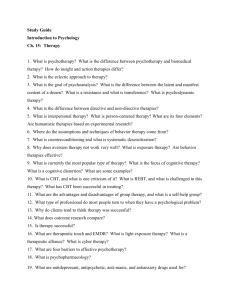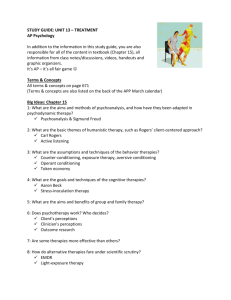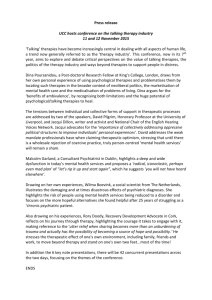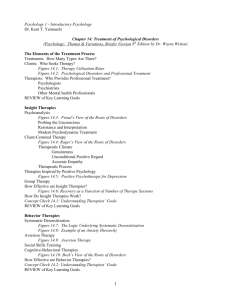Biological and Somatic Treatment of Severe Mental Illness Before Modern Times
advertisement
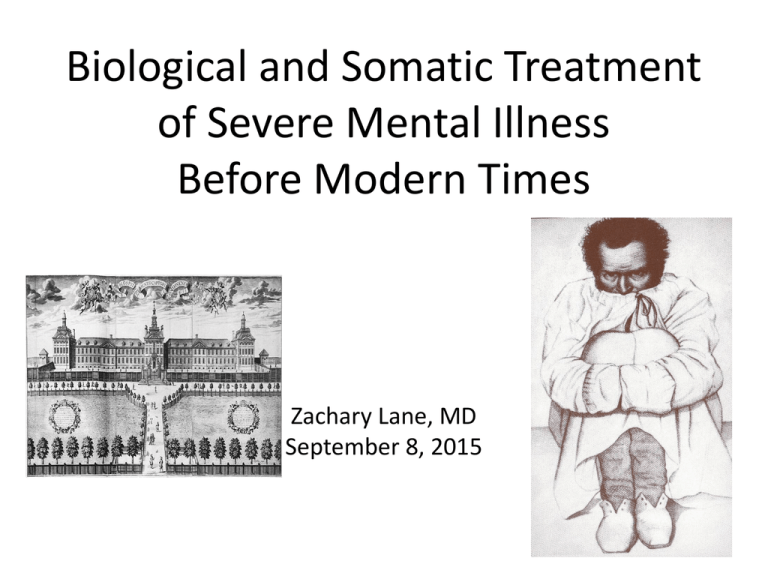
Biological and Somatic Treatment of Severe Mental Illness Before Modern Times Zachary Lane, MD September 8, 2015 Some Early Treatments • Trepanation • Bloodletting • Surgical Bacteriology Some Early Treatments • Tranquilizer Chair • Sensory Deprivation Chair Some Early Treatments • Restraints Asylum Reformation Movement • 18th and 19th Centuries • Moral therapy – Philippe Pinel – Benjamin Rush – Dorothea Dix Early Drug Therapies • • • • Used for behavioral control and sedation Decrease the use of restraints Many nonspecific indications Classes: – Natural remedies • Plant based (Alkaloids) – Synthesized in the lab • Strengthened the link between medical research and psychiatric treatment • Legitimized psychiatric conditions Early Drug Therapies • Natural remedies: – Opium, Morphine • Treat aggression, melancholy, and delusions • The addictive nature, toxicity, and side effects later became evident Early Drug Therapies • Synthesized in the lab (19th Century): – Mercury – treatment for mania – Bromides - treatment for seizures, stress, psychosis, mania, morphine addiction, alcoholism – Chloral Hydrate – hypnotic, “knockout drug” – Paraldehyde - hypnotic Early Drug Therapies • Synthesized in the lab: – Barbiturates (20th Century): • Barbital, Phenobarbital – Hypnotic, anxiolytic, anti-epileptic – Addictive, overdose potential Early Drug Therapies • Synthesized in the lab: – Amphetamines (20th Century): • Antidepressant, weight loss • “Pep pill” or inhalers • Addictive, led to anxiety/psychosis Prolonged Sleep Therapy (Continuous Narcosis) • 1910’s - 1930’s • Continuous administration of bromides or barbiturates • Sleep for 6-8 days • Briefly awaken to eat and toilet • Believed to give rest to an overactive nervous system Prolonged Sleep Therapy (Continuous Narcosis) • Treatment for psychosis, mania, agitated depression, & addictions • Effective for “shellshock” (PTSD) in World War I • Required intensive monitoring • Replaced by Insulin Coma Therapy in 1930’s • Later scandals – CIA’s MKULTRA (mind control) experiments, Australian Chelmsford Scandal Hydrotherapy • 1800’s to mid-1900’s • Using water to relieve “cerebral congestion” – Bring blood away from the brain and to the skin Hydrotherapy • Wet Sheet Pack – Sheet dipped in water and wrapped snuggly around patient for hours – Cold – agitated patient – Warm – frail patient Hydrotherapy • Continuous Bathing – Patient placed in tub with replenishing warm water and fastened in hammock for hours to days Hydrotherapy • Jet Streams and Steam Cabinets Malaria Fever Therapy • Neurosyphilis (General Paresis of the Insane) – Around 20% of patients institutionalized in early 20th Century – Physical and psychiatric problems, high mortality – Immoral patients seen as deserving of their fate – No cure (Penicillin not discovered until 1928) Malaria Fever Therapy • Hippocrates and Galen noted improvements in some patients after malaria • Julius Wagner-Jauregg – injected malaria into patients with Neurosyphilis to induce fever – Later would cure their malaria with Quinine • First full cure for a specific mental illness – Mental illness seen as having a biological cause Malaria Fever Therapy • Why it worked? – High fevers destroyed spirochetes – Stimulated the body’s immune response • Wagner-Jauregg won 1927 Nobel Prize in Medicine Malaria Fever Therapy • Malaria later replaced by other fever inducers into the 1950’s: inject foreign protein/chemicals, immerse in hot bath, electromagnetic currents, full body fever machine Shock Therapies • Shock Therapies: – Insulin Shock Therapy – Metrazol Convulsive Therapy – Electroconvulsive Therapy (ECT) • Initially used for treating psychosis based on erroneous belief that people with epilepsy cannot have comorbid psychosis • All found to be more effective for depression Shock Therapies: Insulin Shock Therapy • 1930’s - 1940’s • Daily injections of high doses of Insulin until coma induced • Treatments lasted hours and were terminated with glucose via IV or NG Tube • Courses lasted for ~60 days and required close monitoring • Replaced in 1940’s by ECT due to Insulin shortage during World War II Shock Therapies: Insulin Shock Therapy Shock Therapies: Metrazol Convulsive Therapy • 1930’s - 1940’s • Metrazol (Pentylenetetrazol) – circulatory and respiratory stimulant • Given via injection 2-3 times/week for several weeks • Caused “explosive seizure” one minute after administration that could cause fractures – Dread after administration • No antidote to reverse • Replaced in 1940’s by ECT Shock Therapies: Electroconvulsive Therapy (ECT) • 1930’s - Present Day • Electrically induced convulsions • Thought convulsions produced vitalizing compounds that had defense properties (“acro amines”) Shock Therapies: Electroconvulsive Therapy (ECT) • Easier to use, lower cost, fewer complications • Curare used in late 1940’s as muscle relaxant to decrease fractures • Amnesia viewed positively – “forget your depression” • ECT declined due to public opinion and the antipsychiatry movement in the 1960’s and 1970’s – more recent resurgence and still in use today as one of the most effective treatments in psychiatry Shock Therapies: Electroconvulsive Therapy (ECT) Warning The video on the following slide shows graphic medical procedures. Viewer discretion is advised. Shock Therapies: Electroconvulsive Therapy (ECT) Lobotomy Warning The video on the following slide shows graphic medical procedures. Viewer discretion is advised. Lobotomy Prefrontal Lobotomy • 1930’s – Egas Moniz • Some patients more docile after accidental frontal lobe damage • Cut strands connecting prefrontal cortex and thalamus – Rationale: neuronal pathways became “fixed” and needed to be disrupted • Initially used as “last resort” in severe cases • Moniz won 1949 Nobel Prize in Medicine Transorbital Lobotomy • 1940’s – Walter Freeman & James Watts • Exploded in popularity – Attempt to relieve state hospital burden – Expanding indications – no longer “last resort” – Took just minutes, no anesthesia, done in clinic – Children and adolescents as well Lobotomy • Initially thought to be a permanent cure but results turned out to be poor • Side effects: personality changes (childlike, disinhibited, apathetic), apraxia, cognitive problems, “lost the sparkle” • Waned in popularity in 1950’s with introduction of antipsychotic medication • Other types of psychosurgery still performed today in select cases Beginning of Modern Era of Psychiatric Treatment Early Modern Antipsychotic Medications • Chlorpromazine (Thorazine) – Synthesized in 1951 for use in general anesthesia – Also found to produce “euphoric quietude” where patients lost interest in their surroundings – First drug effective for psychotic symptoms (and not just sedation) • Dopamine antagonist -> led to dopamine excess theory of Schizophrenia Early Modern Antipsychotic Medications • Chlorpromazine (Thorazine) – Adopted by psychiatrists worldwide by mid-1950’s – Led to further development of 1st generation antipsychotics (neuropleptics) – Began deinstitutionalization movement Early Modern Antidepressant Medications • Iproniazid (1951) – Medication for Tuberculosis – Improved mood in depressed patients – Weak monoamine oxidase inhibitor • Led to monoamine theory of depression Early Modern Antidepressant Medications • Imipramine (1956) – Found serendipitously while trying to manufacture an antipsychotic medication – Improved mood in depressed patients – First Tricyclic Antidepressant (TCA) • Led to creation of other TCA’s and later SSRI’s Concluding Thoughts
